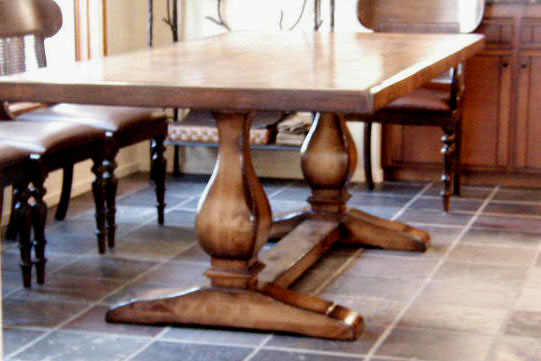Routing an Elliptical Table
CNC techniques are quick and accurate, but can also produce a template for edge work or future jobs. April 10, 2007
Question
I need to fabricate an elliptical table with overall dimensions of 96" x 44" x 1.5". It will consist of veneered plywood with a 2" wide outside edge of mahogany, and will be a true elliptical shape. My current plan is to have the main body cut on a CNC at a local shop, then to use the skeleton from that cutout as a template to route the inside curve of the outer edge material. I plan to offset the cutter by a distance equal to the width of the CNC cutter using a template guide on the router, in order to match the ellipse curves precisely. Before I launch into that approach, I was curious if anyone had any alternate methods of doing this job (read: easier)? All input appreciated.
Forum Responses
(Furniture Making Forum)
From contributor H:
If the CNC is going to cut the main body/blank, the next step would be for them to cut the edge pieces too. It could be done in four segments, all interchangeable in a true oval.
From contributor D:
Using the cut off waste for a guide won't work, never has. If you're not going to let the CNC guy do it, then why don't you just use a bit with a bearing? Put a piece of 1/2" MDF under the top before CNC and you'll have a guide (exact match) for the bearing to run on, if your profile cuts the whole edge. You can also keep this for a future template and not have to outsource any of it. If the bit you have doesn't have a bearing, then you need to get one that does. Have it made if necessary. There you have it - easier. And even easier if you want to make another one in the future. Seems simple, but maybe I’m not understanding the question.
From contributor D:
I was right - I didn't understand the question. Do now, though. Disregard some of the babble above.
From contributor V:
I would either have the CNC guys cut the edge at the same time, so the same guy does the setup and cutting, or have them cut you your template to the correct size out of MDF.
From contributor F:
We do a lot of conference tables. We have a CNC so we draw it in AutoCAD and rout the top and the solid wood nosing on our Thermwood CNC. It does a great job.
From contributor K:
What contributor D said. Just completed three separate ellipse (positive/negatives) for a larger double kidney shaped conference table. Yes, the saved forms are great for future work. The medium of the three turned out to be a perfect shape for a client dinner table. All good. CNC’s the best for match on match, with protected MDF positives and negatives. You can skip the CNC boys next time through and remain productive to the wee hours, no stops.
From contributor N:
You can do this without a CNC by drawing the ellipse on a sheet of 1/4 MDF, cutting it out with standard shop tools, sanding the edges so it's perfect to the eye and then using a $20 inlay jig available from Lee Valley to make perfectly matching positive and negative second generation templates. Those second generation templates get applied to your actual work pieces (field glue-up and border blanks) and are flush cut with the router. It'll come out perfect - I tried it a few years ago on a 1.5" thick 16 foot long maple countertop with curved solid maple border and the glue line was invisible.
Or have the CNC do it - guess it's a matter of time and money. I would have the CNC also make the border template or machine the actual solid wood as suggested above. The offsets on those bushing sets are not very precisely machined I found. With my method you really have to have your cutter exactly the right diameter because even a very small deviation makes for a sloppy joint.
